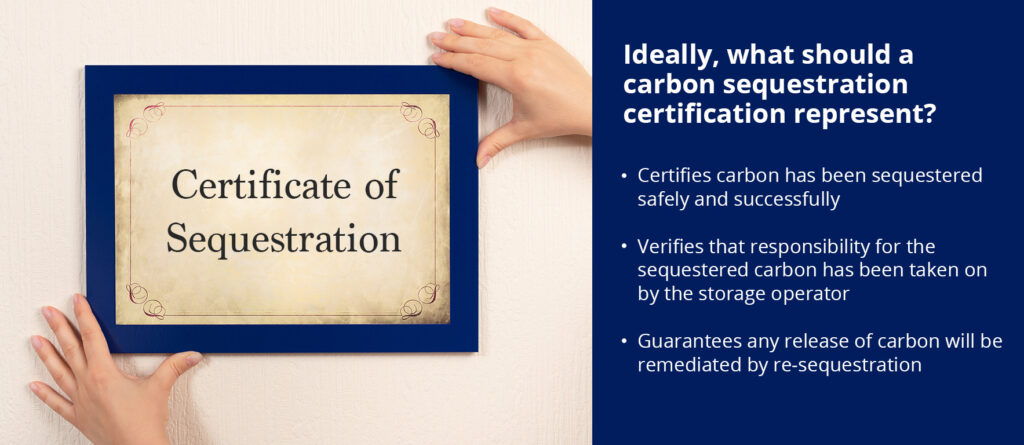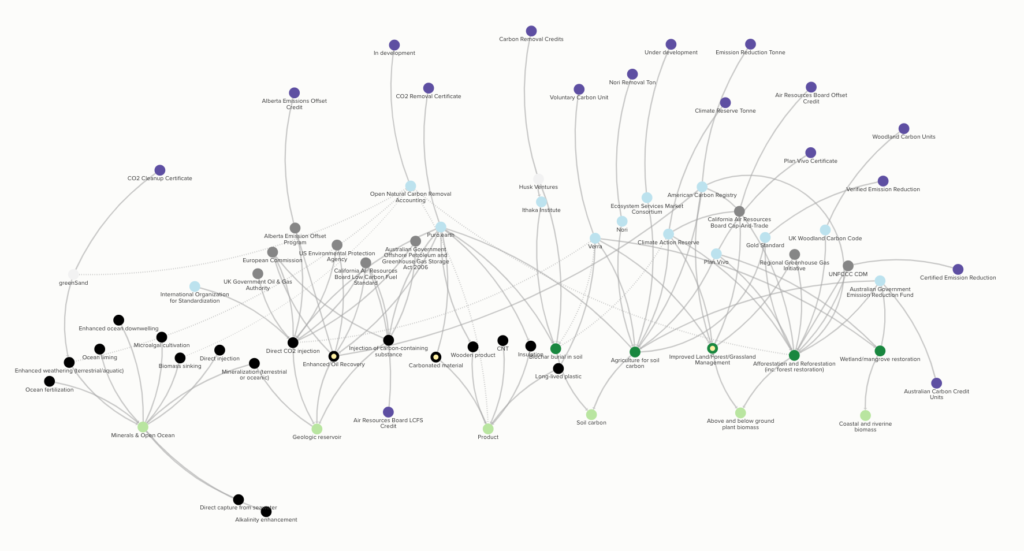
Stephanie Arcusa
Postdoctoral Researcher, Center for Negative Carbon Emissions at Arizona State University
Stephanie is a member of the I-WEST team at ASU. Her contributions to the I-WEST technology roadmap focus on carbon management, workforce development, and how direct air capture (DAC) technologies can play a role in achieving regional carbon neutrality goals.

Many certification schemes for carbon sequestration exist—all with important differences
An assessment of existing certification around the world found at least 20 organizations that develop standards and propose methodologies for various sequestration approaches across six different carbon reservoir types [1]. For the Intermountain West region specifically, the main potential carbon reservoirs are geological formations (e.g., depleted oil and gas wells and saline reservoirs), above and below ground biomass (e.g., reforestation and ecosystem restoration), soil carbon, and minerals (e.g., turning CO2 into stone). Multiple standards exist for each, available in voluntary and compliance carbon markets.
With choice comes differences. For example, CarbonPlan, a non-profit that uses data to analyze climate solutions, reviewed 14 soil carbon certification protocols, finding wide variety in rigor and various other metrics [2]. Many different groups work to guide the public and buyers to make their own quality assessments but clearly, a single set of standards would be in everyone’s best interests [3, 4].
Carbon sequestration efforts are set to increase to meet net-zero targets
The world spent $1B in voluntary carbon credits [5] and $1T in compliance carbon allowances [6] in 2021. This is set to increase. Almost 43% of 632 public companies reviewed across the world plan to use carbon credits to meet their net-zero pledges [7].
The Intergovernmental Panel on Climate Change estimates the need for carbon sequestration to be on the order of 100-1000 gigatons of carbon dioxide over this century to uphold climate goals established by the Paris Agreement [8]. For perspective, the global annual carbon sequestration in geologic reservoirs hit 36.6 million tons in 2021 [9]. The scale of carbon sequestration will be enormous, and the growth of the industry is well underway, but without independent oversight, there’s great potential for fraud, error, and too much variability in standards.
An international certification accreditation system is needed now more than ever
This large amount of sequestration will need to be certified, but the burden of quality assessment should not rest on the public nor on carbon buyers [10]. The certification industry must be held responsible for ensuring a certain level of quality that we expect from other industries. In addition to improving oversight, the industry must also develop guidelines for what constitutes robust certification of carbon sequestration. Committing to an international certification accreditation system would address the public interests of safety and performance while enabling faster standards development.
References
[1] Arcusa, S., and Sprenkle-Hyppolite, S. (2022). Snapshot of the Carbon Sequestration Certification Market Ecosystem. OSF. Preprint. https://doi.org/10.31219/osf.io/fu59w
[2] Zelikova, J., F. Chay, J. Freeman, D. Cullenward (2021). A buyer’s guide to soil carbon offsets. CarbonPlan https://carbonplan.org/research/soil-protocols-explainer [Accessed 03-07-202]
[3] WWF, EDF, and Oeko-Institut (2020). What makes a high-quality carbon credit? Phase 1 of the “Carbon Credit Guidance for Buyers” project: Definition of criteria for assessing the quality of carbon credits”. Available at: https://www.edf.org/sites/default/files/documents/what_makes_a_high_quality_carbon_credit.pdf [Accessed 03-07-2022]
[4] SEI (2019). Securing climate benefit: a guide to using carbon offsets. Available at: https://www.offsetguide.org/ [Accessed 03-07-2022].
[5] Ecosystem Marketplace (2021). Voluntary Carbon Markets Top $1 Billion in 2021 with Newly Reported Trades, a Special Ecosystem Marketplace COP26 Bulletin. Article, 10 Nov 2021. Available at https://www.ecosystemmarketplace.com/articles/voluntary-carbon-markets-top-1-billion-in-2021-with-newly-reported-trades-special-ecosystem-marketplace-cop26-bulletin/ [Accessed 03-07-2022]
[6] Dalal, K. (2022). Intercontinental Exchange reports record volume of 2021 environmental contracts traded. Article, 11 Jan 2022. Available at: https://seekingalpha.com/news/3787111-intercontinental-exchange-reports-record-volume-of-2021-environmental-contracts-traded?utm_medium=referral [Accessed 03-07-2022]
[7] Net-Zero Tracker (2021). Post-COP26 Snapshot. Database, 25 Nov 2021. Available at: https://zerotracker.net/analysis/post-cop26-snapshot/ [Accessed 03-07-2022]
[8] IPCC (2018). Summary for Policymakers. In: Global Warming of 1.5°C. An IPCC Special Report on the impacts of global warming of 1.5°C above pre-industrial levels and related global greenhouse gas emission pathways, in the context of strengthening the global response to the threat of climate change, sustainable development, and efforts to eradicate poverty [Masson-Delmotte, V., P. Zhai, H.-O. Pörtner, D. Roberts, J. Skea, P.R. Shukla, A. Pirani, W. Moufouma-Okia, C. Péan, R. Pidcock, S. Connors, J.B.R. Matthews, Y. Chen, X. Zhou, M.I. Gomis, E. Lonnoy, T. Maycock, M. Tignor, and T. Waterfield (eds.)]. In Press.
[9] Global CCS Institute, 2021. The Global Status of CCS 2021. Australia. Available at: https://www.sustainablefinance.hsbc.com/carbon-transition/carbon-capture-and-storage-2021 [downloaded 28-02-2022].
[10] Microsoft (2021). Microsoft carbon removal lessons from an early corporate purchase. Available at: https://query.prod.cms.rt.microsoft.com/cms/api/am/binary/RE4MDlc [downloaded 11-03-2022].



